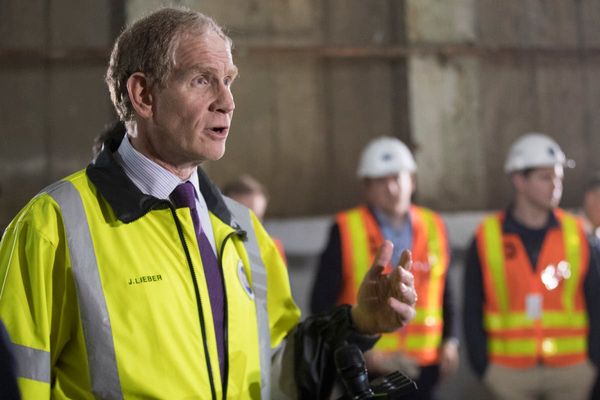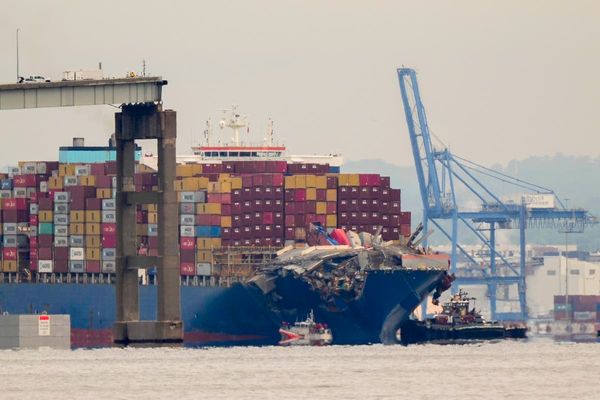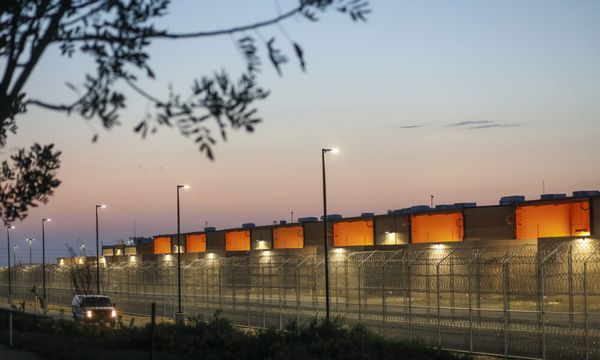
In recent days, grass has begun to grow on the roof of Leonard McDonald’s bushfire bunker, helping it to merge into the New South Wales south coast hinterland bush.
It’s meagre camouflage, though. There is little that can fully distract him from the fact that he now lives beside a six-tonne concrete block submerged in the ground for the express purpose of saving lives in the event of a catastrophic – and not unprecedented – bushfire.
“Even if I would prefer not to think about it, it’s there waiting. It’s eerie,” McDonald, a director of the Multispecies Justice Trust, says. The bunker at the Brogers Creek property he owns with his partner delivers him back to his childhood in North America during the Cuban missile crisis. A palpable sense of foreboding is attached to the structure, with its Pyroglass window and enough space and air for four people for six hours.
Usually buried into soil or the side of a hill, bunkers are solid concrete structures with reinforced flame-proof doors, sometimes with oxygen supplies. They are designed as last-resort options in short, extreme burnovers. For McDonald, the new bunker falls squarely into the category of adaptation in an area that is labelled, in risk parlance, the flame zone. “There’s no escaping the climate crisis now,” he says. He lives, as we all do, with forecasts of more intense and frequent bushfires. When it is not flooding, Australia’s east coast can be a crucible.


“Everything up to 2019-2020 was conceptual,” he says, remembering the wall of fire that threatened his home over the black summer. “Warnings and predictions are very different to having 60-metre high flames approaching. It changed everything.”
When fires came to within 500 metres of Greg and Chantal Roger’s Hunter Valley, NSW, home in early 2020, they were waiting to take delivery of their bunker, which seemed a logical addition to their bushfire armoury after moving from Sydney in 2019.
“I couldn’t conceive why you wouldn’t,” Roger, a doctor and professor of bioengineering at Sydney University, says from his home near Laguna. As a Rural Fire Service volunteer, he is aware of both the value of being on site to extinguish burning embers and spot fires, and the danger of living at the end of a single-lane 2.5km road surrounded on all sides by dense forest.
“Moving into the bush from the city, I thought a bunker would put everyone’s minds at ease. We’re completely off-grid and you need to be self-reliant – fire protection is part of that.”
Anthony Tratt from Wildfire Safety Bunkers says he has installed hundreds of bunkers across all states and territories, except the Northern Territory. With the fire season comes a spike in interest each year although it was, unusually, Maui’s fires which kicked off this year’s busy time. On the day we spoke, he had 18 units lined up and ready to ship. As David Nichols from Rural Container Supplies in Albury, which also makes fire shelters, puts it, “the moment there’s a sight of smoke, all of sudden everybody wants one.”

Everybody, that is, who can afford them.
All up, Roger’s unit cost more than $14,000. McDonald’s version costs about $18,500 to buy, transport and install within a 100km radius of Wildfire Shelters Australia’s Somerville, Victoria factory.
Sonia Akter, a senior lecturer at Australian National University’s Crawford School of Public Policy, has analysed large-scale Australian data on poverty and bushfires – figures that had never been put side-by-side. In two papers, the first of which she co-authored with Prof Quentin Grafton and was partly researched and written in Singapore during the pandemic, she compared socioeconomic disadvantage with bushfire exposure and then with bushfire recovery.
What she found fascinated her. The volume of publicly available data in Australia was far more than anything she had access to in her usual study areas of Bangladesh, Pakistan and the Philippines. But what the Australian data showed was similar to what she knew of developing countries: Australia’s poorest communities are disproportionately affected by bushfires.
She ran the comparisons in remote, regional and urban areas, and on national, NSW and Victorian scales. Not only did their hypotheses hold true but the relationship between poverty and exposure to bushfires was especially robust in regional areas. Stretches of the east coast, including along the NSW-Victoria border, north-west of Sydney and a large swathe of NSW’s north, were the most vulnerable. Even within a small geographical area, some communities experienced higher exposure to fires relative to their less- or non-poor neighbours.
Tratt says his shelters are particularly popular in the affluent area of Warrandyte, to the north-east of central Melbourne.

A paper about wildfires and inequality in the US, published in September, supported Akter and Grafton’s conclusions. “We all know that bushfire intensity and frequency is increasing,” says Akter. “It’s disproportionately affecting poorer people, they are more exposed and have less capacity to recover. It is intensifying poverty in both developing and developed countries.”
And the likes of the United Nations have been warning of the bigger picture for years: The lowest income countries produce one-tenth of global emissions, but are the most heavily affected by climate change.
“Bunkers are for the people who can afford it. We are externalising the cost of climate change and it is unequally distributed,” says McDonald. “We’re enormously privileged to be able to go out and order one and have it put in.”
One claim levelled at bunker owners is that they are secretive about their shelters for fear of being overrun when disaster strikes. It is complicated emotional territory, says McDonald, but both he and Roger expect and plan to provide refuge to their closest neighbours when all hell breaks loose. At any rate, falling trees and thick smoke often make travelling even very short distances impossible.


Akter’s work shows that within bushfire regions in Australia, communities have different capacities to prepare for and overcome large fires – some can afford to volunteer as firefighters or purchase shelters, and some can’t – and that reality must be taken into account when it comes to designing policy, including for fire bunkers.
Building a homemade shelter can have tragic outcomes. Of the 173 people who died in Victoria’s Black Saturday bushfires in 2009, 113 were inside houses or other structures. Eight were in shipping containers, cellars and self-built bunkers.
The CSIRO provided scientific guidance for the development of the Australian Building Codes Board’s private fire shelters performance standard and to Victoria’s Country Fire Authority after Black Saturday. Victoria is the only state or territory that has a clear policy around private bushfire bunkers – and Tratt is one of four fully accredited bushfire bunker providers in the state. The CSIRO knows of six instances in which accredited bushfire bunkers were successfully used during burnovers in the 2019-2020 bushfire season. In three of those cases, fires destroyed homes. In a study published in Fire journal in August, the authors argue that it is time for the federal government to take a more active role in promoting clear and consistent approaches to bunkers across the country.
Underground public fire bunkers aren’t a feature of modern Australian life – despite a design for a 250-person bunker Tratt says he submitted to the Victorian government – but the open (and zero cost) simplicity of a sports ground might be considered a large-capacity shelter in desperate circumstances. Marysville’s Gallipoli Oval will for ever be associated with saving the souls of scores of people on Black Saturday.

Might subsidised fire shelters be a thing of the future? Prof Clive Williams of ANU’s Centre for Military and Security Law has argued that it should be possible to design and install a mass-produced structure, similar to Anderson shelters used in the second world war, to withstand bushfires for under $1,000. Roger’s bunker, on the other hand, comes with the option of shelves or a wine rack – and alongside the storage of essential paperwork, data-filled hard drives and family documents, he does indeed house wine there. Whether ever used to save lives or not, bunkers make ideal vaults.
Still, bunkers like Roger’s are basic when considering the apocalypse shelters on offer to the global super elite. Swiss company Oppidum advertises underground bunkers – optional majlis (sitting rooms), parking, staff quarters, swimming pool and gym – starting at US$8m. In tech-mastered trompe l’oeil, rooms open to faux sky, fooling brains into forgetting the almost 15 metres of soil above.

The kind of bunkers we’re more used to are criticised for their ability to trick us, too. Authorities have long worried that private shelters, even if accredited, may lull people into a false sense of security. The RFS and Victorian Building Authority are unyielding: shelters are a last-resort option and not a substitute for a bushfire plan and leaving early.
But for many who live in the flame zone, security is a thing of the past. There is prudence, there is immense community strength and there are varying budgets. And, there is also the hope, of course, that those who own bunkers never have to use them.







